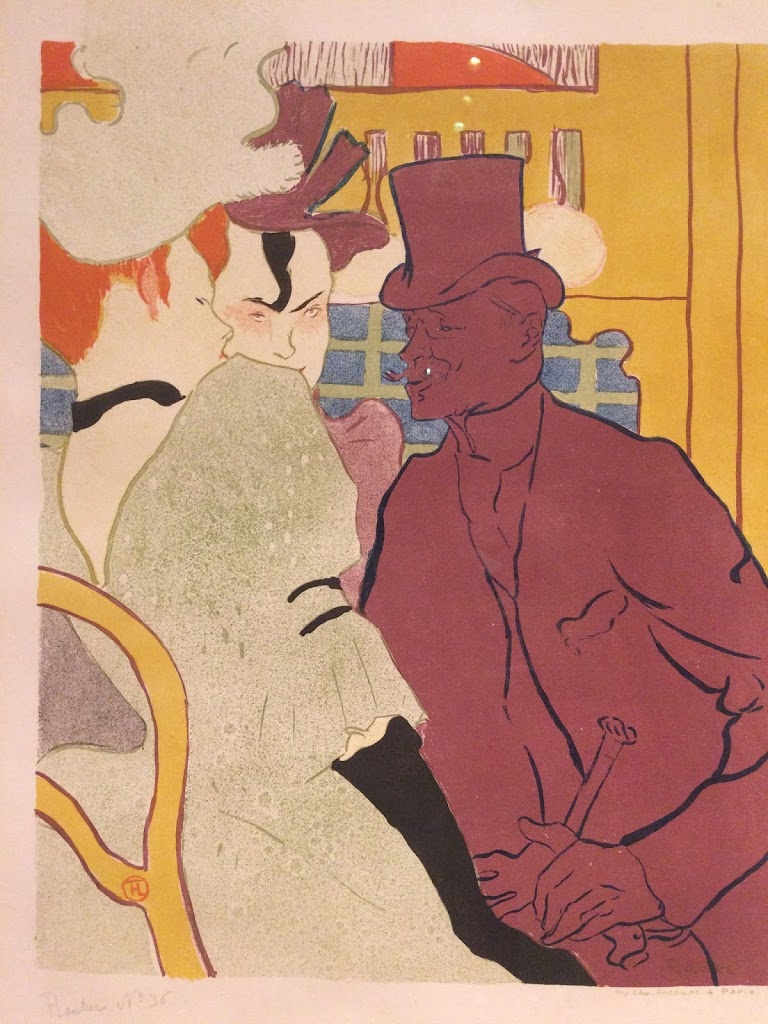 |
| The Artisan Moderne. 1896, Lautrec was asked to advertise a jeweler/home goods designer He manages to add some of his own thoughts and observations about human nature. |
 |
| Mademoiselle Eglantine’s Troupe, 1895- 1896 Brush, spatter and crayon lithograph in three colors. The dance troup included Jane Avril, seen below |
He’s best known for creating poster advertisement for entertainers and other highlights of Paris night life. Certainly he did a lot to bolster the careers of certain singers and performers such “La Goulue,” Jane Avril and Aristide Bruant. His posters were all over the kiosks of Paris and his work began a new trend. Although Lautrec was from an aristocratic background, he reveled in the demimonde and the bohemian lifestyle. He captured the people, places and events with so much vitality that the viewer almost wishes he or she could be there. The “Belle Epoque” is the beautiful era and in the USA it reflects the time of “The Gilded Age or “The Gay Nineties.”
Furthermore, it’s not only performers and night clubs that he enjoys. One of his friends, Sescau asked him to advertise his photography studio. He sets the fashionable lady in the foreground, running away from the photographer. With his sly humor, he makes suggests that photographer friend is looking at her in other ways, too. In a brilliant display of his design talent, the frills of this woman’s flowing cape match the rhythms of design in her fan, flowing in the opposite direction off the edge of the page.
 |
| Photographer Sescau, 189 Brush, crayon and spatter lithograph, printed in five colors. Key stone printed in blue; color stones in red, yellow and green |
Like other artists of his time — Van Gogh and Munch — he used jumps in space to heighten the meaning. It works well with the poster; the graphic artist’s challenge is to say a great deal with a minimal amount of detail and definition. In one of his most famous works, La Goulue at the Moulin Rouge, the master of ceremonies is at the picture plane. He’s merely a silhouette with pointed fingers, pointing to the artist’s signature put also to the celebrity whose dancing a can-can. Le Moulin Rouge was a 1890s version of “Dancing with the Stars.” Guests were able to mix and mingle with their favorite celebrities, and to dance alongside them.
 |
| La Goulue (Louise Weber) |
Of course the Moulin Rouge was also memorialized with a fictional character played by Nicole Kidman in Baz Luhrmann’s 2001 movie, Moulin Rouge. The story, but not the aesthetics in the move, fit with the time and place. John Leguizamo played Toulouse-Lautrec as an affable, good-natured character. Since childhood accidents and perhaps a genetic disease kept him from growing to normal adult height, he felt comfortable with other outsiders.
In actuality, La Goulue was Louise Weber, who had moved from the country (Alsace) into the city as a teen. She was approximately 24 at the time of her stardom as one of the most popular dancers in Paris. Her nickname, “the glutton” probably refers to how she took from others — food and drink.By the time she was 30, she was tired, wasted, impoverished and alcoholic. (In his prints, and paintings, she’s always recognized by her topknot. ) Unfortunately, there’s similar sad tales played out by some young stars today.
 |
| La Goulue at the Moulin Rouge, Brush and Spatter lithograph, printed on two sheets of wove paper. Final print |



Recent Comments